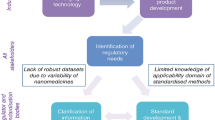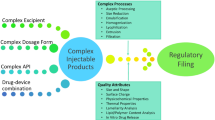Abstract
Purpose
This study was aimed at developing sustained-release orodispersible films (ODFs) based on drug–resin complexes (DRCs) to improve medication compliance with donepezil hydrochloride (DPH), the first-line treatment for Alzheimer’s disease.
Methods
DPH was formulated as DRCs using a batch method to retard drug release and mask the bitterness of DPH. The effects of particle size, drug-to-resin ratio, and reaction temperature on the complexation efficiency, drug loading capacity, and particle size distribution were investigated. The resultant DRCs were evaluated for in vitro release, taste-masking efficiency, and physicochemical properties. The ODFs were prepared using DRCs of various particle sizes and their physical properties, in vitro release, and release kinetics were evaluated.
Results
Both the complexation efficiency and drug loading capacity of DRCs increased with smaller particle sizes, higher temperatures, and drug-to-resin ratios close to 1. However, drug release depended only on particle size, which was inversely proportional to the release rate. Although the particle size of DRC was comparable to that of the corresponding resin, it slightly increased with increasing drug loading capacity. The bitterness of DPH was masked, and drug leakage was avoided owing to ionic bond formation. The ODFs showed good physical properties regardless of the particle size of the DRCs, and the release profile of the ODFs was equivalent to their corresponding DRCs.
Conclusion
This study is the first to develop sustained-release ODFs of DPH. Their use could improve medication compliance in patients with Alzheimer’s disease.






Similar content being viewed by others
References
Abetz L, Rofail D, Mertzanis P, Heelis R, Rosa K et al (2009) Alzheimer’s disease treatment: Assessing caregiver preferences. Adv Ther 26(6):627–644. https://doi.org/10.1007/s12325-009-0034-5
Akkaramongkolporn P, Terada K, Yonemochi E (2001) Molecular properties of propranolol hydrochloride prepared as drug–resin complexes. Drug Dev Ind Pharm 27(4):359–364. https://doi.org/10.1081/DDC-100103736
Al-Asmari AK, Ullah Z, Tariq M, Fatani A (2016) Preparation, characterization, and in vivo evaluation of intranasally administered liposomal formulation of donepezil. Drug Des Devel Ther 10:205–215. https://doi.org/10.2147/DDDT.S93937
Alayoubi A, Daihom B, Adhikari H, Mishra S, Helms R et al (2016) Development of a taste-masked oral suspension of clindamycin HCl using ion exchange resin Amberlite IRP 69 for use in pediatrics. Drug Dev Ind Pharm 42(10):1579–1589. https://doi.org/10.3109/03639045.2016.1160102
Alzheimer’s Association (2020) 2020 Alzheimer’s disease facts and figures. Alzheimers Dement 16:391–460. https://doi.org/10.1002/alz.12068
Anand V, Kanarapu R, Garg S (2001) Ion-exchange resins: carrying drug delivery forward. Drug Discov Today 6(17):905–914. https://doi.org/10.1016/S1359-6446(01)01922-5
Borges AF, Silva C, Coelho JFJ, Simões S (2015) Oral films: current status and future perspectives: I—galenical development and quality attributes. J Control Release 206:1–19. https://doi.org/10.1016/j.jconrel.2015.03.006
Boyd GE, Adamson AW, Myers LS Jr (1947) The exchange adsorption of ions from aqueous solutions by organic zeolites. II. Kinetics1. J Am Chem Soc 69(11):2836–2848. https://doi.org/10.1021/ja01203a066
Brniak W, Maślak E, Jachowicz R (2015) Orodispersible films and tablets with prednisolone microparticles. Eur J Pharm Sci 75:81–90. https://doi.org/10.1016/j.ejps.2015.04.006
Chang R-K, Shinwari M, Leonzio M, Wu L-S, Pang J et al (1998) Evaluation of the disintegrant properties for and experimental, crosslinked polyalkylammonium polymer. Int J Pharm 173(1–2):87–92. https://doi.org/10.1016/S0378-5173(98)00218-X
Choi J, Choi M-K, Chong S, Chung S-J, Shim C-K et al (2012) Effect of fatty acids on the transdermal delivery of donepezil: In vitro and in vivo evaluation. Int J Pharm 422(1–2):83–90. https://doi.org/10.1016/j.ijpharm.2011.10.031
Choi DH, Kim NA, Nam TS, Lee S, Jeong SH (2014) Evaluation of taste-masking effects of pharmaceutical sweeteners with an electronic tongue system. Drug Dev Ind Pharm 40(3):308–317. https://doi.org/10.3109/03639045.2012.758636
Deng Y, Wang T, Li J, Sun W, He H et al (2020) Studies on the in vitro ion exchange kinetics and thermodynamics and in vivo pharmacokinetics of the carbinoxamine-resin complex. Int J Pharm 588:119779. https://doi.org/10.1016/j.ijpharm.2020.119779
Di Stefano A, Iannitelli A, Laserra S, Sozio P (2011) Drug delivery strategies for Alzheimer’s disease treatment. Expert Opin Drug Deliv 8(5):581–603. https://doi.org/10.1517/17425247.2011.561311
Dogan N, McHugh TH (2007) Effects of microcrystalline cellulose on functional properties of hydroxy propyl methyl cellulose microcomposite films. J Food Sci 72(1):E016–E022. https://doi.org/10.1111/j.1750-3841.2006.00237.x
FDA (1997) Guidance for industry: dissolution testing of immediate release solid oral dosage forms. Food and Drug Administration, Center for Drug Evaluation and Research, Rockville
Flach CR, Brauner JW, Mendelsohn R (1993) Calcium ion interactions with insoluble phospholipid monolayer films at the A/W interface. External reflection-absorption IR studies. Biophys J 65(5):1994–2001. https://doi.org/10.1016/S0006-3495(93)81276-1
Fu S-Y, Feng X-Q, Lauke B, Mai Y-W (2008) Effects of particle size, particle/matrix interface adhesion and particle loading on mechanical properties of particulate–polymer composites. Compos Part B Eng 39(6):933–961. https://doi.org/10.1016/j.compositesb.2008.01.002
Gijare C, Deshpande A (2018) Orodispersible films: a systematic patent review. Recent Pat Drug Deliv Formul 12(2):110–120. https://doi.org/10.2174/1872211312666180509100216
Guhmann M, Preis M, Gerber F, Pöllinger N, Breitkreutz J et al (2012) Development of oral taste masked diclofenac formulations using a taste sensing system. Int J Pharm 438(1–2):81–90. https://doi.org/10.1016/j.ijpharm.2012.08.047
Han X, Zhang S, Chai Z, Dong Y, He W et al (2019) In vitro and in vivo evaluation of the taste-masking efficiency of Amberlite IRP88 as drug carries in chewable tablets. J Drug Deliv Sci Technol 49:547–555. https://doi.org/10.1016/j.jddst.2018.12.002
Herrmann N, Binder C, Dalziel W, Smyth S, Camacho F (2009) Persistence with cholinesterase inhibitor therapy for dementia: an observational administrative health database study. Drugs Aging 26(5):403–407. https://doi.org/10.2165/00002512-200926050-00004
Horner J, Alberts MJ, Dawson DV, Cook GM (1994) Swallowing in Alzheimer’s disease. Alzheimer Dis Assoc Disord 8(3):177–189. https://doi.org/10.1097/00002093-199408030-00004
Ikkai F, Shibayama M (1996) Microstructure and swelling behavior of ion‐exchange resin. J Polym Sci Part B Polym Phys 34(9):1637–1645. https://doi.org/10.1002/(SICI)1099-0488(19960715)34:9<1637::AID-POLB13>3.0.CO;2-8
Irwin WJ, Belaid KA, Alpar HO (1987) Drug-delivery by ion-exchange. Part III: Interaction of ester pro-drugs of propranolol with cationinc exchange resins. Drug Dev Ind Pharm 13(9–11):2047–2066. https://doi.org/10.3109/03639048709068706
Irwin WJ, Belaid KA, Alpar HO (1988) Drug-delivery by ion-exchange. Part IV: Coated resinate complexes of ester pro-drugs of propranolol. Drug Dev Ind Pharm 14(10):1307–1325. https://doi.org/10.3109/03639048809151935
Jeong SH, Park K (2008a) Development of sustained release fast-disintegrating tablets using various polymer-coated ion-exchange resin complexes. Int J Pharm 353(1–2):195–204. https://doi.org/10.1016/j.ijpharm.2007.11.033
Jeong SH, Park K (2008b) Drug loading and release properties of ion-exchange resin complexes as a drug delivery matrix. Int J Pharm 361(1–2):26–32. https://doi.org/10.1016/j.ijpharm.2008.05.006
Kearney MC, Caffarel-Salvador E, Fallows SJ, McCarthy HO, Donnelly RF (2016) Microneedle-mediated delivery of donepezil: potential for improved treatment options in Alzheimer’s disease. Eur J Pharm Biopharm 103:43–50. https://doi.org/10.1016/j.ejpb.2016.03.026
Kim J-I, Cho S-M, Cui J-H, Cao Q-R, Oh E et al (2013) In vitro and in vivo correlation of disintegration and bitter taste masking using orally disintegrating tablet containing ion exchange resin–drug complex. Int J Pharm 455(1–2):31–39. https://doi.org/10.1016/j.ijpharm.2013.07.072
Kim TH, Shin S, Bulitta JB, Youn YS, Yoo SD et al (2017) Development of a physiologically relevant population pharmacokinetic in vitro–in vivo correlation approach for designing extended-release oral dosage formulation. Mol Pharm 14(1):53–65. https://doi.org/10.1021/acs.molpharmaceut.6b00677
Kimura S-i, Uchida S, Kanada K, Namiki N (2015) Effect of granule properties on rough mouth feel and palatability of orally disintegrating tablets. Int J Pharm 484(1–2):156–162. https://doi.org/10.1016/j.ijpharm.2015.02.023
Liang AC, Chen L-LH (2001) Fast-dissolving intraoral drug delivery systems. Expert Opin Ther Patents 11(6):981–986. https://doi.org/10.1517/13543776.11.6.981
Liu Z, Cheung R, Wu XY, Ballinger JR, Bendayan R et al (2001) A study of doxorubicin loading onto and release from sulfopropyl dextran ion-exchange microspheres. J Control Release 77(3):213–224. https://doi.org/10.1016/S0168-3659(01)00473-4
Malladi M, Jukanti R, Nair R, Wagh S, Padakanti HS et al (2010) Design and evaluation of taste masked dextromethorphan hydrobromide oral disintegrating tablets. Acta Pharm 60(3):267–280. https://doi.org/10.2478/v10007-010-0025-8
Mazumder S, Pavurala N, Manda P, Xu X, Cruz CN et al (2017) Quality by design approach for studying the impact of formulation and process variables on product quality of oral disintegrating films. Int J Pharm 527(1–2):151–160. https://doi.org/10.1016/j.ijpharm.2017.05.048
Müller MJ (2006) Attitudes toward different formulations of psychotropic drugs. Am J Drug Deliv 4(1):33–41. https://doi.org/10.2165/00137696-200604010-00004
Preis M, Knop K, Breitkreutz J (2014) Mechanical strength test for orodispersible and buccal films. Int J Pharm 461(1–2):22–29. https://doi.org/10.1016/j.ijpharm.2013.11.033
Reichenberg D (1953) Properties of ion-exchange resins in relation to their structure. III. Kinetics of exchange. J Am Chem Soc 75(3):589–597. https://doi.org/10.1021/ja01099a022
Ronchi F, Sereno A, Paide M, Sacré P, Guillaume G et al (2019) Development and evaluation of an omeprazole-based delayed-release liquid oral dosage form. Int J Pharm 567:118416. https://doi.org/10.1016/j.ijpharm.2019.06.007
Saluja S, Kasha PC, Paturi J, Anderson C, Morris R et al (2013) A novel electronic skin patch for delivery and pharmacokinetic evaluation of donepezil following transdermal iontophoresis. Int J Pharm 453(2):395–399. https://doi.org/10.1016/j.ijpharm.2013.05.029
Shang R, Liu C, Quan P, Zhao H, Fang L (2018) Effect of drug-ion exchange resin complex in betahistine hydrochloride orodispersible film on sustained release, taste masking and hygroscopicity reduction. Int J Pharm 545(1–2):163–169. https://doi.org/10.1016/j.ijpharm.2018.05.004
Speer I, Preis M, Breitkreutz J (2018) Prolonged drug release properties for orodispersiblefilms by combining hot-melt extrusion and solvent casting methods. Eur J Pharm Biopharm 129:66–73. https://doi.org/10.1016/j.ejpb.2018.05.023
Speer I, Lenhart V, Preis M, Breitkreutz J (2019) Prolonged release from orodispersible films by incorporation of diclofenac loaded micropellets. Int J Pharm 554:149–160. https://doi.org/10.1016/j.ijpharm.2018.11.013
Sutthapitaksakul L, Dass CR, Sriamornsak P (2021) Donepezil—an updated review of challenges in dosage form design. J Drug Deliv Sci Technol 63:102549. https://doi.org/10.1016/j.jddst.2021.102549
Visser JC, Weggemans OAF, Boosman RJ, Loos KU, Frijlink HW et al (2017) Increased drug load and polymer compatibility of bilayered orodispersible films. Eur J Pharm Sci 107:183–190. https://doi.org/10.1016/j.ejps.2017.07.010
Vrbinc M, Jordan-Kotar B, Smrkolj M, Vrečer F (2007) Characterization of physical forms of donepezil hydrochloride. Acta Chim Slov 54(2):254–267
Yan Y-D, Woo JS, Kang JH, Yong CS, Choi H-G (2010) Preparation and evaluation of taste-masked donepezil hydrochloride orally disintegrating tablets. Biol Pharm Bull 33(8):1364–1370. https://doi.org/10.1248/bpb.33.1364
Yewale CP, Rathi MN, Kore GG, Jadhav GV, Wagh MP (2013) Formulation and development of taste masked fast-disintegrating tablets (FDTs) of chlorpheniramine maleate using ion-exchange resins. Pharm Dev Technol 18(2):367–376. https://doi.org/10.3109/10837450.2011.627870
Acknowledgements
This research was supported by the Industrial Strategic Technology Development Program (No. 10076291) funded By the Ministry of Trade, Industry & Energy (MOTIE, Korea).
Author information
Authors and Affiliations
Corresponding author
Ethics declarations
Conflict of interest
All authors (H.-R. Park, S.H. Seok, K.-M. Hwang, J.-Y. Kim, C.-W. Park, and E.-S. Park) declare no conflicts of interest.
Statement of human and animal rights
This article does not contain any studies with human or animal subjects performed by any of the authors.
Additional information
Publisher’s Note
Springer Nature remains neutral with regard to jurisdictional claims in published maps and institutional affiliations.
Supplementary Information
Below is the link to the electronic supplementary material.
Rights and permissions
About this article
Cite this article
Park, HR., Seok, S.H., Hwang, KM. et al. Formulation of sustained-release orodispersible film containing drug–resin complexes of donepezil hydrochloride. J. Pharm. Investig. 52, 259–272 (2022). https://doi.org/10.1007/s40005-022-00560-4
Received:
Accepted:
Published:
Issue Date:
DOI: https://doi.org/10.1007/s40005-022-00560-4




